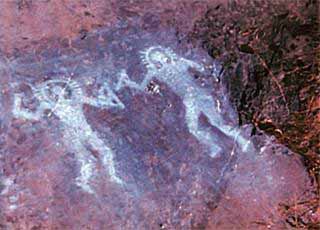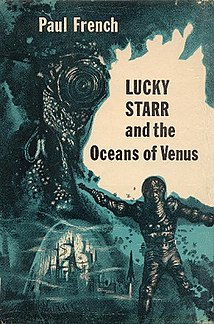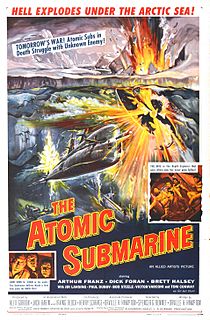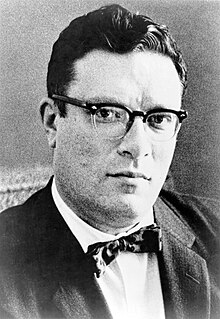Plot summary
"The Watery Place" is narrated by the unnamed deputy sheriff of Twin Gulch, Idaho, who opens the story by explaining that humanity will never achieve space travel. This, he says, is due to his boss, Sheriff Bart Cameron. The deputy explains that Cameron is an impatient man generally, and becomes particularly impatient when he's working on his income taxes. It was the world's bad fortune that the first extraterrestrials to land on Earth happened to arrive in Twin Gulch, Idaho on the evening of 14 April 1956.

Human spaceflight is space travel with a crew or passengers aboard the spacecraft. Spacecraft carrying people may be operated directly, by human crew, or it may be either remotely operated from ground stations on Earth or be autonomous, able to carry out a specific mission with no human involvement.
An income tax is a tax imposed on individuals or entities (taxpayers) that varies with respective income or profits. Income tax generally is computed as the product of a tax rate times taxable income. Taxation rates may vary by type or characteristics of the taxpayer.

An extraterrestrial or alien is any extraterrestrial lifeform; a lifeform that did not originate on Earth. The word extraterrestrial means "outside Earth". The first published use of extraterrestrial as a noun occurred in 1956, during the Golden Age of Science Fiction.
The deputy sees a flying saucer land while staring out the window of the sheriff's office, and sees the two occupants approach. The aliens look perfectly human, and are dressed in ordinary business suits. The deputy notes, "I would have thought they were city fellows if I hadn't seen the flying saucer land in the scrub." Cameron is too busy working on his taxes to notice the landing.

A flying saucer is a descriptive term for a supposed type of flying craft having a disc or saucer-shaped body, commonly used generically to refer to an anomalous flying object. The term was coined in 1930 but has generally been supplanted since 1952 by the United States Air Force term unidentified flying objects or UFOs. Early reported sightings of unknown "flying saucers" usually described them as silver or metallic, sometimes reported as covered with navigation lights or surrounded with a glowing light, hovering or moving rapidly, either alone or in tight formations with other similar craft, and exhibiting high maneuverability.
The aliens enter and explain to Cameron that they have chosen to make first contact with humanity in Twin Gulch because it is isolated and peaceful, and that they have chosen Cameron to make first contact with because he is the local leader. "We come from the watery place your people call Venus." They want Cameron's help contacting the leaders of the United States of America.

First contact is a common science fiction theme about the first meeting between humans and extraterrestrial life, or of any sentient race's first encounter with another one, given they are from different planets or natural satellites.

Venus is the second planet from the Sun, orbiting it every 224.7 Earth days. It has the longest rotation period of any planet in the Solar System and rotates in the opposite direction to most other planets. It does not have any natural satellites. It is named after the Roman goddess of love and beauty. It is the second-brightest natural object in the night sky after the Moon, reaching an apparent magnitude of −4.6 – bright enough to cast shadows at night and, rarely, visible to the naked eye in broad daylight. Orbiting within Earth's orbit, Venus is an inferior planet and never appears to venture far from the Sun; its maximum angular distance from the Sun (elongation) is 47.8°.

The United States of America (USA), commonly known as the United States or America, is a country composed of 50 states, a federal district, five major self-governing territories, and various possessions. At 3.8 million square miles, the United States is the world's third or fourth largest country by total area and is slightly smaller than the entire continent of Europe's 3.9 million square miles. With a population of over 327 million people, the U.S. is the third most populous country. The capital is Washington, D.C., and the largest city by population is New York City. Forty-eight states and the capital's federal district are contiguous in North America between Canada and Mexico. The State of Alaska is in the northwest corner of North America, bordered by Canada to the east and across the Bering Strait from Russia to the west. The State of Hawaii is an archipelago in the mid-Pacific Ocean. The U.S. territories are scattered about the Pacific Ocean and the Caribbean Sea, stretching across nine official time zones. The extremely diverse geography, climate, and wildlife of the United States make it one of the world's 17 megadiverse countries.
This sets Cameron off. He storms at them, calls them wise-guy jerks, and threatens to lock them up for disturbing the peace. He finishes by saying, "Get the hell out of here and back to wherever you're from and don't ever come back. I don't want to see you and no one else around here does." The alien can tell that Cameron is serious, so he says that he will leave, and see to it that nobody ever returns and that Cameron's people will never have to leave. The deputy can tell that he means it, and that humanity will be fenced in on Earth forever.
After the aliens leave, the outraged deputy drags Cameron over to the window and makes him watch as the flying saucer takes off. He asks why Cameron sent them away. When Cameron says he thought they were just foreigners, the deputy reminds him that they said they were from Venus. Cameron responds, "Venus! When they talked about the watery place, I thought they meant Venice!"

Venice is a city in northeastern Italy and the capital of the Veneto region.

Foundation and Earth is a science fiction novel by American writer Isaac Asimov, the fifth novel of the Foundation series and chronologically the last in the series. It was published in 1986, four years after the first sequel to the Foundation trilogy, which is titled Foundation's Edge.

George Adamski was a Polish American citizen who became widely known in ufology circles, and to some degree in popular culture, after he claimed to have photographed spaceships from other planets, met with friendly Nordic alien Space Brothers, and to have taken flights with them to the Moon and other planets.

"Ancient astronauts" refers to the pseudoscientific idea that intelligent extraterrestrial beings visited Earth and made contact with humans in antiquity and prehistoric times. Proponents suggest that this contact influenced the development of modern cultures, technologies, and religions, and even human biology. A common position is that deities from most, if not all, religions are extraterrestrial in origin, and that advanced technologies brought to Earth by ancient astronauts were interpreted as evidence of divine status by early humans.
The extraterrestrial hypothesis (ETH) proposes that some unidentified flying objects (UFOs) are best explained as being physical spacecraft occupied by extraterrestrial life or non-human aliens, or non occupied alien probes from other planets visiting Earth.
According to the post-1900 publications of Theosophy, Lord Sunat Kumara is an "Advanced Being" at the Ninth level of initiation who is regarded as the 'Lord' or 'Regent' of Earth and of the humanity, and is thought to be the head of the Spiritual Hierarchy of Earth who dwells in Shamballah.
In ufology, the psychosocial hypothesis, abbreviated PSH, argues that at least some UFO reports are best explained by psychological or social means. It is often contrasted with the better-known extraterrestrial hypothesis (ETH), and is particularly popular among UFO researchers in the United Kingdom, such as David Clarke, Hilary Evans, the editors of Magonia magazine, and many of the contributors to Fortean Times magazine. It is also popular in France since the publication in 1977 of a book written by Michel Monnerie, Et si les ovnis n'existaient pas?.

The 27th Day is a 1957 American black-and-white science fiction film from Columbia Pictures, produced by Helen Ainsworth, directed by William Asher, and starring Gene Barry, Valerie French, George Voskovec, and Arnold Moss. The screenplay by John Mantley is based on his 1956 original science fiction novel of the same name.

Lucky Starr and the Oceans of Venus is the third novel in the Lucky Starr series, six juvenile science fiction novels by Isaac Asimov that originally appeared under the pseudonym Paul French. The novel was first published by Doubleday & Company in 1954. Since 1972, reprints have included a foreword by Asimov explaining that advancing knowledge of conditions on Venus have rendered the novel's descriptions of that world inaccurate.
Contactees are persons who claim to have experienced contact with extraterrestrials. Some claimed ongoing encounters, while others claimed to have had as few as a single encounter. Evidence is anecdotal in all cases.

Earth vs. the Flying Saucers is a 1956 American black-and-white science fiction film from Columbia Pictures, produced by Charles H. Schneer, directed by Fred F. Sears, that stars Hugh Marlowe and Joan Taylor. Earth vs. the Flying Saucers was released as a double feature with The Werewolf.

In science fiction and ufology, a Venusian or Venerian is a native inhabitant of the planet Venus. Many science fiction writers have imagined what extraterrestrial life on Venus might be like.

Resplendent is an English language science fiction collection by British writer Stephen Baxter, published in 2006. It is the fourth and final book in the Destiny's Children series.
A UFO religion is any religion in which the existence of extraterrestrial (ET) entities operating unidentified flying objects (UFOs) is an element of belief. Typically, adherents of such religions believe the ETs to be interested in the welfare of humanity which either already is, or eventually will become, part of a pre-existing ET civilization. Others may incorporate ETs into a more supernatural worldview in which the UFO occupants are more akin to angels than physical aliens; this distinction may be blurred within the overall subculture. These religions have their roots in the tropes of early science fiction and weird fiction writings, in ufology, and in the subculture of UFO sightings and alien abduction stories.
"The Chameleon" is an episode of the original The Outer Limits television show. It first aired on 27 April 1964, during the first season.
Aladino Félix (1905–2004), better known by his pen name Dino Kraspedon, was a Brazilian author, right-wing paramilitary leader, and self-proclaimed messiah of the Jewish people, who claimed in a 1959 book to have been contacted by an extraterrestrial from Jupiter. Much information of a scientific, medical, and moral nature is given in his book.

The Atomic Submarine is a 1959 independently made American black-and-white science fiction film drama, produced by Alex Gordon, directed by Spencer Gordon Bennet, that stars Arthur Franz, Dick Foran, Brett Halsey, and Joi Lansing, with John Hilliard as the voice of the alien. The film was distributed by Allied Artists Pictures Corporation.

The Day the Earth Stopped is a 2008 American direct-to-DVD science fiction film produced by independent studio The Asylum, directed by and starring C. Thomas Howell. Its title and premise are similar to those of the 2008 remake of The Day the Earth Stood Still but the film's plot also incorporates elements from other science-fiction films involving aliens, such as Transformers, Independence Day and Earth vs. the Flying Saucers. The film is Howell's second Asylum film in which he was attached as director, the first being War of the Worlds 2: The Next Wave.
"A Day in Beaumont" is the first segment of the twenty-fourth episode of the first season (1985–86) of the television series The Twilight Zone.

Stranger from Venus is a 1954 independently made British black-and-white science fiction film, produced by Burt Balaban, Gene Martel, and Roy Rich, that stars Patricia Neal and Helmut Dantine.



















